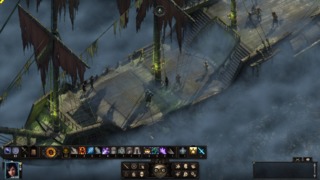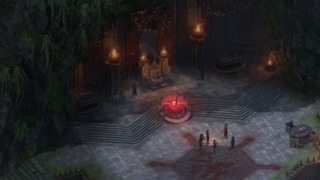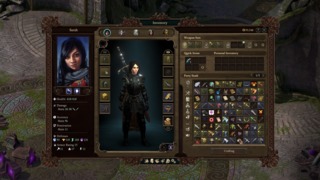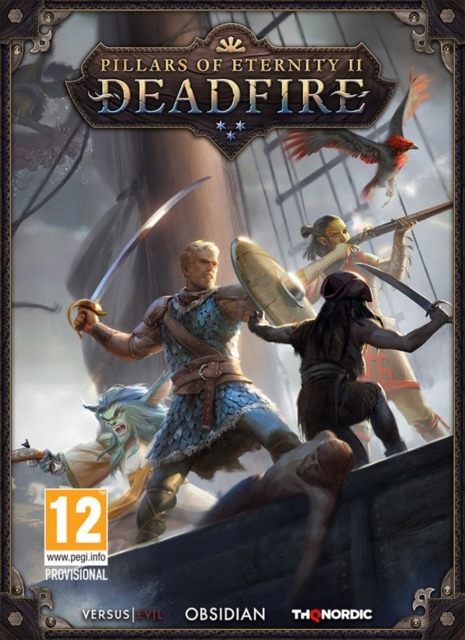Crimson Tide
The legacy of the Infinity Engine is very much the marrow in my gaming bones. Like many my RPG teeth were cut on the original Baldur’s Gate and it’s hard to convey just how much of an impact it had. Its vast and intricate world was unlike anything I had seen before having spent my most formative years with the Atari 7800 and Sega’s Master System. It along with Sid Meier’s Civilization introduced me to the majesty of PC gaming and memories of lost weekends in front of the family PC linger still.
Whilst I never managed to get around to Planescape: Torment I did play Baldur’s Gate II and it remains one of the best games I’ve ever played and certainly the most significant in terms of its influence on my tastes. For better or worse it made me into the massive fantasy nerd I am today and inculcated a lifelong love of RPGs. The loot, the stories, the adventure, the weird and wonderful worlds full of magic and danger, no other genre has so captured my imagination.
As such I’ve longed for another experience that can match the glory that was Bioware’s magnum opus. Many have I tried, and many were of similar quality, but nothing has quite managed to capture that unique feeling I had as a child of Bhaal.

Funny then, that in the original Pillars of Eternity we were introduced to The Wheel, the name of the process by which the souls of the dead are reincarnated into new bodies, be they human or beast. In the case of its sequel Deadfire, I can’t help but chuckle at the thought that maybe the soul of Baldur’s Gate II has finally found its way back to us.
I had high hopes for the first game, but despite my best efforts to enjoy it I could not help but be disappointed. Its story, whilst mature and interesting in terms of its ideas, felt impersonal and more interested in its own lore than anything to do with the player. Likewise combat felt off, maybe a result of my atrophied CRPG brain but nevertheless it was a struggle to get to grips with and enjoy. However someone on the Obsidian design team must clearly be of my spiritual kin as the follow up is, in the words of Heraclitus, ‘fucking amazing’.
Pillars of Eternity II picks up from where the last game left off but you don’t really need to have played it to get a grasp of what’s going on. You, a watcher – someone who can commune with the souls of the dead – have been left half dead by a newly risen god and have to chase his rather large buttocks around the Deadfire Archipelago at the behest of another god who has concerns for what this might mean for the world of Eora.
What follows is a grand sea adventure where you must hunt down the rogue god whilst dealing with the fallout left in his wake. Political turmoil, cultural tensions and personal tragedies abound and it is up to you as to whom to help or hinder, or otherwise ignore entirely.
What initially may seem like another disappointing lurch towards the complete tyranny of open world design as forwarded by Bethesda, Obsidian have taken the Elder Scrolls narrative design and its Jackson Pollock arrangement of quests and interwoven them into what feels a much more 'alive' and dynamic world. Characters drive the plot rather than events, their motivations and personalities create the tension and grants even the more ancillary quests a degree of richness.

Similarly the metaphysics of Eora, the nuance of its geography and peoples are presented with far more elegance than is typical and does well to try and attract those put off by its predecessors' overly dense/boring storytelling; exposition dumps are a rarity and there is a general economy of language in the writing that keeps your hand away from the skip key. This is tied with expanded use of voice in dialogue; every interaction is fully voiced save the NPCs that exist merely to populate the maps and it makes the process of following along with the story so much easier, not to mention engrossing. The quality of performance is very high and despite some occasionally jarring accents is remarkably consistent and varied given the sheer volume of it.
Likewise the world building is extraordinary; the level of detail that has gone into the myriad gods, creatures, cultures and customs is perhaps unmatched in modern gaming. Eora feels cohesive and immerses you in its weighty and intricate history without suffocating you with it. The ambition on show is remarkable and almost threatens to topple over with all the interweaving quests and levels of agency afforded to your character in completing them. There are dozens of classes and sub-classes, origins and dispositions which can influence your interactions. That it all somehow manages to fit together and feel meaningful leaves me to wonder how some games ever manage to be called RPGs. I spent hours and hours just working out which ‘role’ I wanted to play; not because I could not find something fun or interesting to try, rather there were too many to choose from, and once you consider the time commitment needed to see matters to their end it becomes quite a significant decision.
Combat has very much the look and feel of its forebears; pausing to set up attack queues, positioning party members to make best use of their skills etc. The party AI options however add a useful alternative for those who are not so keen on micromanaging the battles themselves. Various AI routines can be setup and tweaked to allow the armchair general to sit back and revel in their carefully laid plans. That said those looking to test themselves will have to micromanage by necessity owing to the demands of the harder difficulties, and with a one save file option there are more than enough options for the diffuse demands of the RPG lover.

Naval warfare in Deadfire however takes the form of a text and turn based battle system. Each takes a turn to pick an action be it manoeuvring or setting the cannons loose and the goal is to either sink your opponent or otherwise board them, provided you have the crew strength to seize the rival ship. It's not overly complex but works well and provides a fun diversion from the usual land battles. The ability to pick from different ship types, upgrade your cannons and hull, along with recruiting and training your crew makes for a compelling mechanic given the modest budget afforded to it.
Visually the game strikes a balance between looking attractive whilst not allowing its depth to be compromised. The use of pre-rendered backgrounds over polygonal models, whilst a relic of the past and similarly used to cut development costs, is smart in that these backgrounds are almost always lavish and beautiful whilst granting licence to spend more time prettying up the character models and adding more sweet loot to find.
It's all very thoughtful, like the culmination of many many years in service to the genre. There are lots of neat ideas, such as having unique and upgradeable weapons and armour in every quest and uncharted island, allowing for you to freely explore but without the dead end disappointment of yet another identical cave with some gold and a sword you already have 3 of. Or its use of achievements, turning them into a currency for modifying new games to help incentivise repeat play.
That Pillars of Eternity II opens almost identically to Fallout: New Vegas with you being left for dead and having to pursue your attacker shouldn't leave you thinking that it's yet another Obsidian RPG. There are a handful of bugs and crashes to remind you of who's behind it all but Deadfire marks their greatest work so far. Its world and its characters, its combat and richness of role-playing potential are all some of the very best you will find, far from the fetid stench of loot boxes and engagement analytics.
